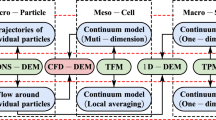Abstract
In this work we address a contribution to the study of particle laden fluid flows in scales smaller than TFM (two-fluid models). The hybrid model is based on a Lagrangian–Eulerian approach. A Lagrangian description is used for the particle system employing the discrete element method (DEM), while a fixed Eulerian mesh is used for the fluid phase modeled by the finite element method (FEM). The resulting coupled DEM-FEM model is integrated in time with a subcycling scheme. The aforementioned scheme is applied in the simulation of a seabed current to analyze which mechanisms lead to the emergence of bedload transport and sediment suspension, and also quantify the effective viscosity of the seabed in comparison with the ideal no-slip wall condition. A simulation of a salt plume falling in a fluid column is performed, comparing the main characteristics of the system with an experiment.


























Similar content being viewed by others
References
Topin V, Dubois F, Monerie Y, Perales F, Wachs A (2011) Micro-rheology of dense particulate flows: application to immersed avalanches. J Non-Newton Fluid Mech 166(1):63–72
Chhabra RP (2012) Bubbles, drops, and particles in non-Newtonian fluids. CRC press, Boca Raton
Peker SM, Helvaci SS (2011) Solid-liquid two phase flow. Elsevier, Amsterdam
Phillips RJ, Armstrong RC, Brown RA, Graham AL, Abbott JR (1992) constitutive equation for concentrated suspensions that accounts for shear-induced particle migration. Phys Fluids A 4(1):30–40
Zhang DZ, Prosperetti A (1997) Momentum and energy equations for disperse two-phase flows and their closure for dilute suspensions. Int J Multiph Flow 23(3):425–453
Wu S, Yuan L (2015) A hybrid FD-DEM solver for rigid particles in viscous fluid. Comput Fluids 118:159–166
Van der Hoef MA, Annaland MS, Deen NG, Kuipers JAM (2008) Numerical simulation of dense gas-solid fluidized beds: a multiscale modeling strategy. Annu Rev Fluid Mech 40:47–70
Hoomans BPB, Kuipers JAM, Briels WJ, Van Swaaij WPM (1996) Discrete particle simulation of bubble and slug formation in a two-dimensional gas-fluidised bed: a hard-sphere approach. Chem Eng Sci 51(1):99–118
Shimizu Y (2004) Fluid coupling in PFC2D and PFC3D. Numerical modeling in micromechanics via particle methods. In: Proceedings of the 2nd international PFC symposium, Kyoto, pp 281–287
Elias RN, Martins MAD, Coutinho ALGA (2005) Parallel edge-based inexact newton solution of steady incompressible 3D navier-stokes equations., Euro-Par 2005 parallel processingSpringer, Berlin, pp 1237–1245
Cho SH, Choi HG, Yoo JY (2005) Direct numerical simulation of fluid flow laden with many particles. Int J Multiph Flow 31(4):435–451
Radjaï F, Dubois F (2011) Discrete-element modeling of granular materials. Wiley-ISTE, New York
Cundall PA, Strack ODL (1979) A discrete numerical model for granular assemblies. Geotechnique (Thomas Telford) 29(1):47–65
O’Sullivan C (2011) Particulate discrete element modelling: a geomechanics perspective. Taylor & Francis, New York
Kobayashi T, Kawaguchi T, Tanaka T, Tsuji Y (2002) DEM analysis on flow pattern of Geldart’s group A particles in fluidized bed. In: Proceedings of the world congress on particle technology, pp 21–25
Li J, Kuipers JAM (2002) Effect of pressure on gas-solid flow behavior in dense gas-fluidized beds: a discrete particle simulation study. Powder Technol 127(2):173–184
Li J, Kuipers JAM (2003) Gas-particle interactions in dense gas-fluidized beds. Chem Eng Sci 58(3):711–718
Moon SJ, Kevrekidis IG, Sundaresan S (2006) Particle simulation of vibrated gas-fluidized beds of cohesive fine powders. Ind Eng Chem Res 45(21):6966–6977
Ye M, Van der Hoef MA, Kuipers JAM (2005) The effects of particle and gas properties on the fluidization of Geldart A particles. Chem Eng Sci 60(16):4567–4580
Batchelor GK (2000) An introduction to fluid dynamics. Cambridge University Press, Cambridge
Hallermeier RJ (1981) Terminal settling velocity of commonly occurring sand grains. Sedimentology 28(6):859–865
Hoomans BPB, Kuipers JAM, Van Swaaij WPM (2000) Granular dynamics simulation of segregation phenomena in bubbling gas-fluidised beds. Powder Technol 109(1):41–48
Anderson TB, Jackson R (1967) Fluid mechanical description of fluidized beds. Equations of motion. Ind Eng Chem Fundam 6(4):527–539
Kuipers JAM, Van Duin KJ, Van Beckum FPH, Van Swaaij WPM (1992) A numerical model of gas-fluidized beds. Chem Eng Sci 47(8):1913–1924
Wen CY, Yu YH (1966) Mechanics of fluidization. Chem Eng Prog Symp Ser 62:100–111
Rowe PN, Henwood GA (1961) Drag forces in a hydraulic model of a fluidized bed-part I. Trans Inst Chem Eng 39:43–54
Elias RN, Coutinho ALGA (2007) Stabilized edge-based finite element simulation of free-surface flows. Int J Numer Methods Fluids 54((6–8)):965–993
Guerra GM, Zio S, Camata JJ, Rochinha FA, Elias RN, Paraizo PLB, Coutinho ALGA (2013) Numerical simulation of particle-laden flows by the residual-based variational multiscale method. Int J Numer Methods Fluids 73(8):729–749
Lins EF, Elias RN, Rochinha FA, Coutinho ALGA (2010) Residual-based variational multiscale simulation of free surface flows. Comput Mech 46(4):545–557
Bouillard JX, Lyczkowski RW, Gidaspow D (1989) Porosity distribution in a fluidized bed with an immersed obstacle. AlIChE J 35(6):908–922
Belytschko T, Yen HJ, Mullen R (1979) Mixed methods for time integration. Comput Methods Appl Mech Eng 17:259–275
Zienkiewicz OC, Taylor RL, Zhu JZ (2013) The finite element method: its basis and fundamentals, 7th edn. Butterworth-Heinemann, Saint Louis
Asgian MI, Cundall PA, Brady BH (1995) Mechanical stability of propped hydraulic fractures—a numerical study. J Pet Technol (Society of Petroleum Engineers) 47(3):203–208
Bear J (2012) Hydraulics of groundwater. Courier Dover Publications, New York
Lohner R (1995) Robust, vectorized search algorithms for interpolation on unstructured grids. J Comput Phys 118(2):380–387
Munjiza AA (2004) The combined finite-discrete element method. Wiley, Chichester
Zhu HP, Zhou ZY, Yang RY, Yu AB (2007) Discrete particle simulation of particulate systems: theoretical developments. Chem Eng Sci 62(13):3378–3396
Acknowledgments
The authors gratefully acknowledge the partial support provided by Petrobras S.A., the Brazilian Oil Company, CNPq, the National Research Counsil, and ANP, the National Petroleum Agency.
Author information
Authors and Affiliations
Corresponding author
Rights and permissions
About this article
Cite this article
Casagrande, M.V.S., Alves, J.L.D., Silva, C.E. et al. A hybrid FEM-DEM approach to the simulation of fluid flow laden with many particles. Comp. Part. Mech. 4, 213–227 (2017). https://doi.org/10.1007/s40571-016-0102-y
Received:
Revised:
Accepted:
Published:
Issue Date:
DOI: https://doi.org/10.1007/s40571-016-0102-y




